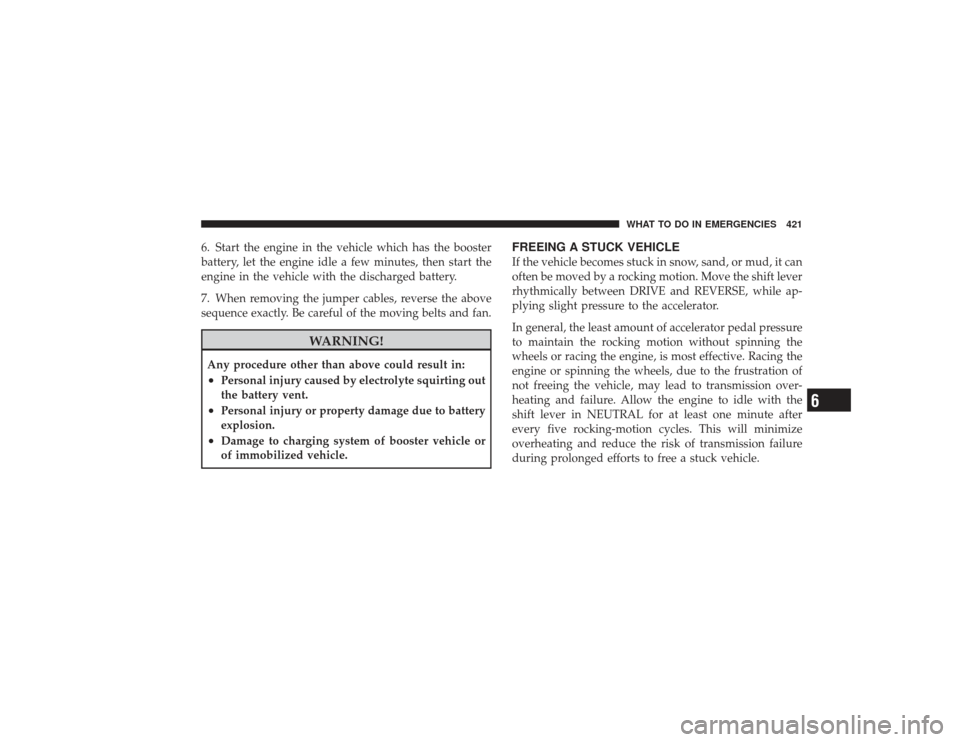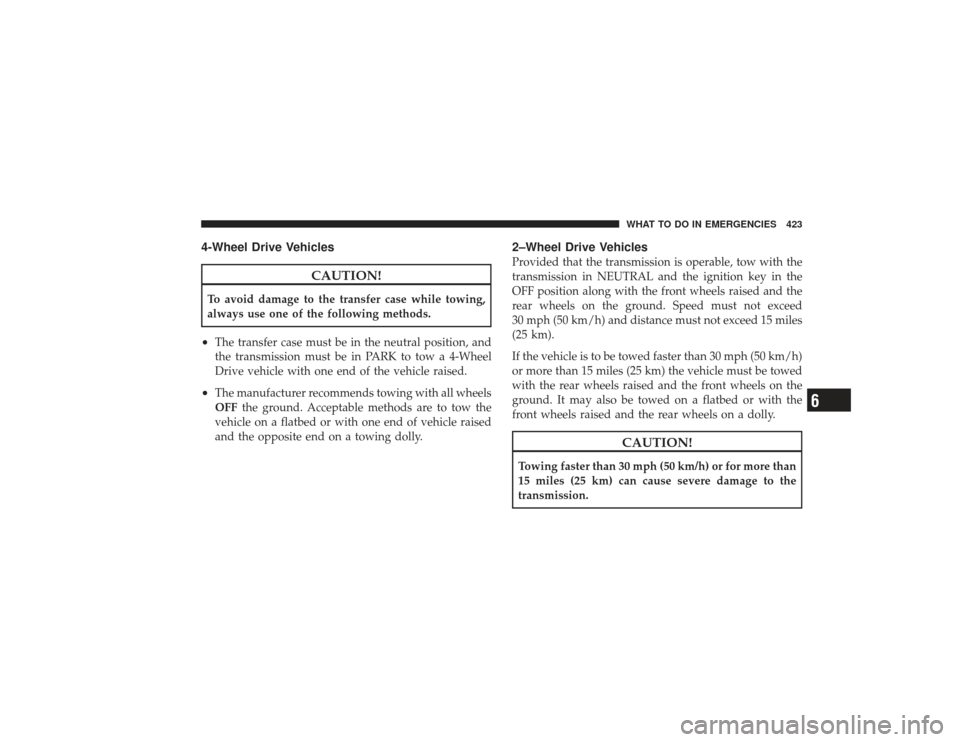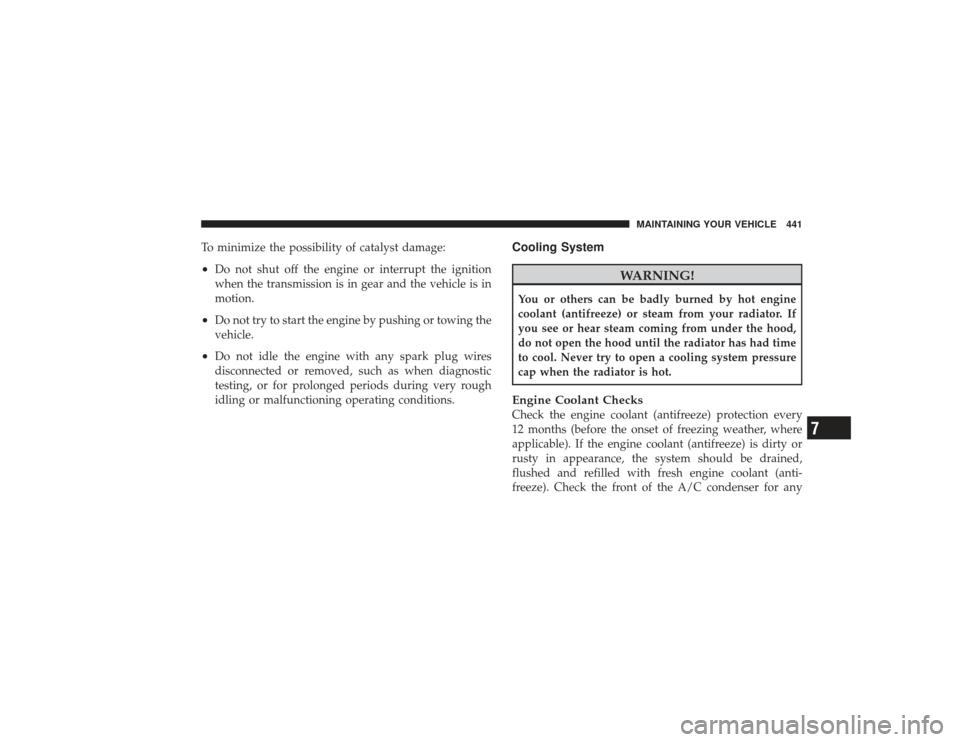Page 423 of 532

6. Start the engine in the vehicle which has the booster
battery, let the engine idle a few minutes, then start the
engine in the vehicle with the discharged battery.
7. When removing the jumper cables, reverse the above
sequence exactly. Be careful of the moving belts and fan.
WARNING!
Any procedure other than above could result in:•
Personal injury caused by electrolyte squirting out
the battery vent.
•
Personal injury or property damage due to battery
explosion.
•
Damage to charging system of booster vehicle or
of immobilized vehicle.
FREEING A STUCK VEHICLEIf the vehicle becomes stuck in snow, sand, or mud, it can
often be moved by a rocking motion. Move the shift lever
rhythmically between DRIVE and REVERSE, while ap-
plying slight pressure to the accelerator.
In general, the least amount of accelerator pedal pressure
to maintain the rocking motion without spinning the
wheels or racing the engine, is most effective. Racing the
engine or spinning the wheels, due to the frustration of
not freeing the vehicle, may lead to transmission over-
heating and failure. Allow the engine to idle with the
shift lever in NEUTRAL for at least one minute after
every five rocking-motion cycles. This will minimize
overheating and reduce the risk of transmission failure
during prolonged efforts to free a stuck vehicle.
WHAT TO DO IN EMERGENCIES 421
6
Page 425 of 532

4-Wheel Drive Vehicles
CAUTION!
To avoid damage to the transfer case while towing,
always use one of the following methods.•
The transfer case must be in the neutral position, and
the transmission must be in PARK to tow a 4-Wheel
Drive vehicle with one end of the vehicle raised.
•
The manufacturer recommends towing with all wheels
OFFthe ground. Acceptable methods are to tow the
vehicle on a flatbed or with one end of vehicle raised
and the opposite end on a towing dolly.
2–Wheel Drive VehiclesProvided that the transmission is operable, tow with the
transmission in NEUTRAL and the ignition key in the
OFF position along with the front wheels raised and the
rear wheels on the ground. Speed must not exceed
30 mph (50 km/h) and distance must not exceed 15 miles
(25 km).
If the vehicle is to be towed faster than 30 mph (50 km/h)
or more than 15 miles (25 km) the vehicle must be towed
with the rear wheels raised and the front wheels on the
ground. It may also be towed on a flatbed or with the
front wheels raised and the rear wheels on a dolly.
CAUTION!
Towing faster than 30 mph (50 km/h) or for more than
15 miles (25 km) can cause severe damage to the
transmission.
WHAT TO DO IN EMERGENCIES 423
6
Page 428 of 532

▫Cooling System .................... 441
▫ Brake System ...................... 447
▫ Rear Axle And 4X4 Front Driving Axle Fluid
Level ............................. 448
▫ Transfer Case ...................... 449
▫ Automatic Transmission .............. 449
▫ Appearance Care And Protection From
Corrosion .......................... 452
� Fuses ............................. 458
▫ Integrated Power Module ............. 458
� Vehicle Storage ...................... 463
� Replacement Light Bulbs ............... 464
� Bulb Replacement .................... 465
▫ Headlight (Halogen)/Front Park And Turn
Lights ............................ 465 ▫
Fog Lights ........................ 468
▫ Tail, Stop, Turn And Backup Lights ...... 469
▫ Center High-Mounted Stoplight (CHMSL)
With Cargo Light .................... 472
▫ Cab Top Clearance Lights — If Equipped . . 473
▫ Tailgate ID Lights (Dual Rear Wheels) —
If Equipped ........................ 475
▫ Rear Light Bar ID Marker
(Dual Rear Wheel) — If Equipped ........ 476
▫ Side Marker Lights (Dual Rear Wheels) . . . 477
� Fluids And Capacities ................. 478
� Fluids, Lubricants And Genuine Parts ...... 479
▫ Engine ........................... 479
▫ Chassis .......................... 480
426 MAINTAINING YOUR VEHICLE
Page 429 of 532
ENGINE COMPARTMENT— 5.7L1 — Air Cleaner Filter7 — Power Steering Fluid Reservoir
2 — Automatic Transmission Dipstick 8 — Engine Oil Dipstick
3 — Engine Oil Fill 9 — Washer Fluid Reservoir
4 — Brake Fluid Reservoir 10 — Engine Coolant Reservoir
5 — Battery 11 — Coolant Pressure Cap
6 — Integrated Power Module MAINTAINING YOUR VEHICLE 427
7
Page 430 of 532

ONBOARD DIAGNOSTIC SYSTEM (OBD II)Your vehicle is equipped with a sophisticated onboard
diagnostic system called OBDII. This system monitors
the performance of the emissions, engine, and automatic
transmission control systems. When these systems are
operating properly, your vehicle will provide excellent
performance and fuel economy, as well as engine emis-
sions well within current government regulations.
If any of these systems require service, the OBD II system
will turn on the Malfunction Indicator Light (MIL). It will
also store diagnostic codes and other information to
assist your service technician in making repairs. Al-
though your vehicle will usually be drivable and not
need towing, see your authorized dealer for service as
soon as possible.
CAUTION!
•
Prolonged driving with the MIL on could cause
further damage to the emission control system. It
could also affect fuel economy and drivability. The
vehicle must be serviced before any emissions
tests can be performed.
•
If the MIL is flashing, severe catalytic converter
damage and power loss will soon occur. Immedi-
ate service is required.
Loose Fuel Filler Cap MessageIf the vehicle’s diagnostic system determines that the fuel
filler cap in loose, improperly installed, or damaged, a
GASCAP message will be displayed in the instrument
cluster. Tighten the gas cap until a “clicking” sound is
heard. This is an indication that the gas cap is properly
tightened. Press the odometer reset button to turn the
message off. If the problem persists, the message will
428 MAINTAINING YOUR VEHICLE
Page 443 of 532

To minimize the possibility of catalyst damage:•
Do not shut off the engine or interrupt the ignition
when the transmission is in gear and the vehicle is in
motion.
•
Do not try to start the engine by pushing or towing the
vehicle.
•
Do not idle the engine with any spark plug wires
disconnected or removed, such as when diagnostic
testing, or for prolonged periods during very rough
idling or malfunctioning operating conditions.
Cooling System
WARNING!
You or others can be badly burned by hot engine
coolant (antifreeze) or steam from your radiator. If
you see or hear steam coming from under the hood,
do not open the hood until the radiator has had time
to cool. Never try to open a cooling system pressure
cap when the radiator is hot.Engine Coolant ChecksCheck the engine coolant (antifreeze) protection every
12 months (before the onset of freezing weather, where
applicable). If the engine coolant (antifreeze) is dirty or
rusty in appearance, the system should be drained,
flushed and refilled with fresh engine coolant (anti-
freeze). Check the front of the A/C condenser for any
MAINTAINING YOUR VEHICLE 441
7
Page 451 of 532

NOTE:The presence of water in the gear lubricant will
result in corrosion and possible failure of differential
components. Operation of the vehicle in water, as may be
encountered in some off-highway types of service, will
require draining and refilling the axle to avoid damage.
2500/3500 Model Axles DO NOT REQUIREany limited
slip oil additive (friction modifiers).Transfer Case
Drain And RefillRefer to the “Maintenance Schedule” in Section 8 for the
proper maintenance intervals.Lubricant SelectionRefer to “Fluids, Lubricants, and Genuine Parts” in this
section for the correct fluid type.
Fluid Level CheckThis fluid level can be checked by removing the filler
plug. The fluid level should be to the bottom edge of the
filler plug hole with the vehicle in a level position.Automatic Transmission
Selection Of LubricantIt is important that the proper lubricant is used in the
transmission to assure optimum transmission perfor-
mance. Use only the manufacturer ’s recommended trans-
mission fluid. Refer to “Fluids, Lubricants, and Genuine
Parts” in this section for the correct fluid type. It is
important that the transmission fluid be maintained at
the prescribed level using the recommended fluid. No
chemical flushes should be used in any transmission;
only the approved lubricant may be used.
MAINTAINING YOUR VEHICLE 449
7
Page 452 of 532

CAUTION!
Using a transmission fluid other than the manufac-
turer’s recommended fluid may cause deterioration
in transmission shift quality and/or torque converter
shudder. Using a transmission fluid other than the
manufacturer’s recommended fluid will result in
more frequent fluid and filter changes. Refer to
“Fluids, Lubricants, and Genuine Parts” in this sec-
tion for correct fluid type.Fluid Level CheckIf your vehicle is equipped with a dipstick, use the
following procedure. If your vehicle has a capped dip-
stick tube, it is sealed and should not be tampered with.
Your authorized dealer has the proper tools to ensure that
the fluid level is set properly. The fluid level should be
checked when the engine is fully warmed up and thefluid in the transmission is at normal operating tempera-
ture. Operation of the transmission with an improper
fluid level will greatly reduce the life of the transmission
and of the fluid. Check the fluid level whenever the
vehicle is serviced.
Fluid Level Check – 545RFECheck the fluid level while the transmission is at normal
operating temperature 82°C (180°F). This occurs after at
least 15 miles (25 km) of driving. At normal operating
temperature the fluid cannot be held comfortably be-
tween the fingertips.
To check the automatic transmission fluid level properly,
the following procedure must be used:
1. Operate the engine at idle speed and normal operating
temperature.
2. The vehicle must be on level ground.
450 MAINTAINING YOUR VEHICLE